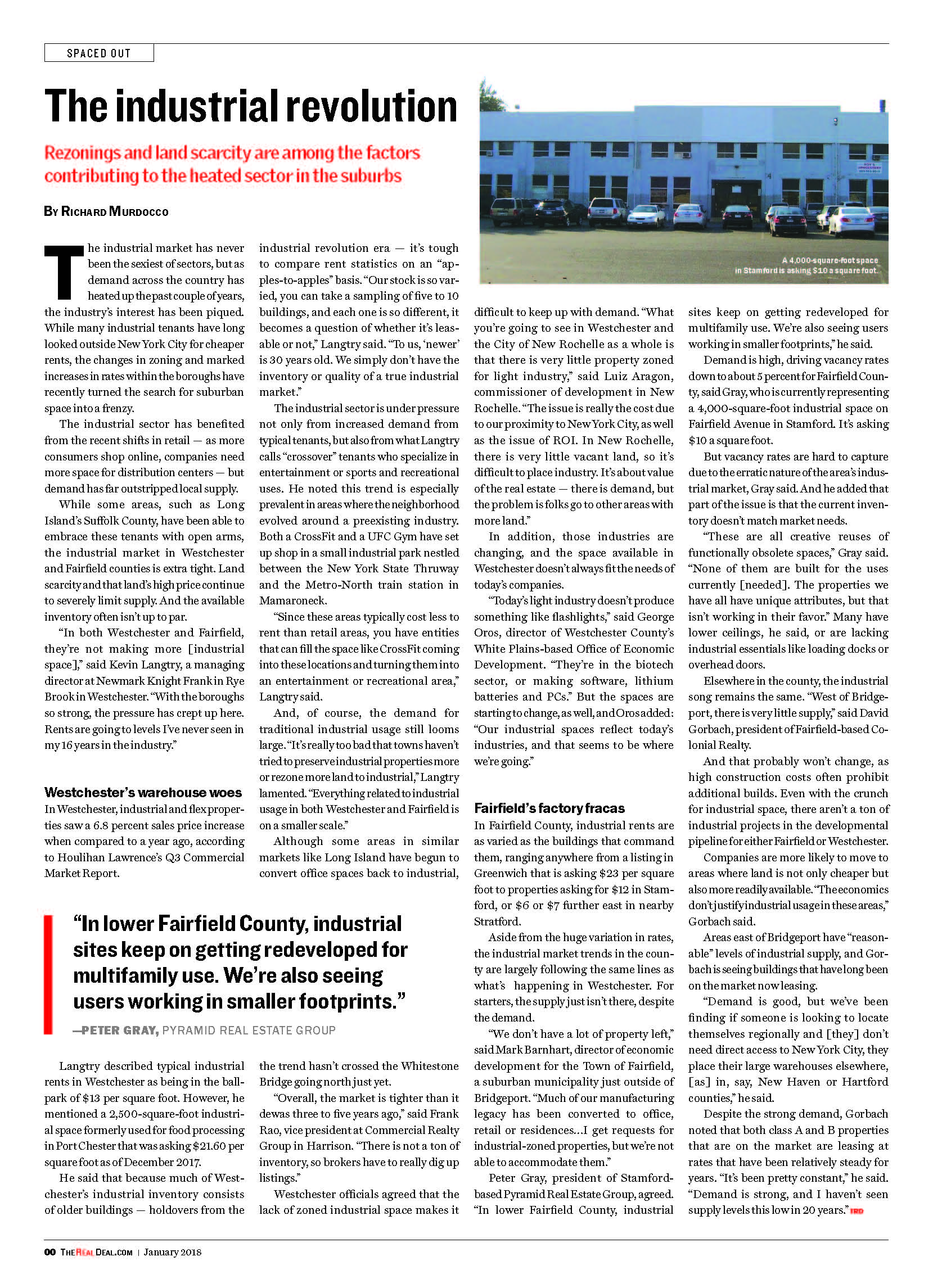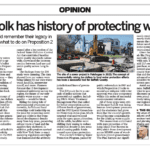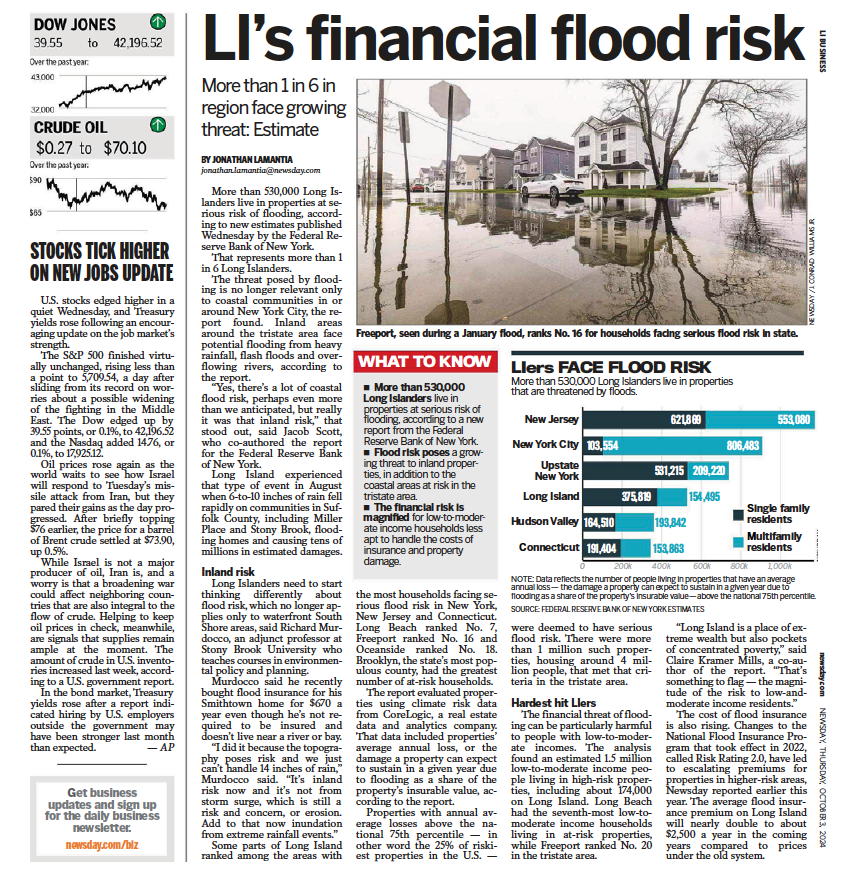The following was published in the special Westchester/Fairfield County edition of The Real Deal Magazine in January 2018. You can read the original here.
The industrial market has never been the sexiest of sectors, but as demand across the country has heated up the past couple of years, the industry’s interest has been piqued. While many industrial tenants have long looked outside New York City for cheaper rents, the changes in zoning and marked increase in rates within the boroughs have recently turned the search for suburban space into a frenzy.
The industrial sector has benefited from the recent shifts in retail — as more consumers shop online, companies need more space for distribution centers — but demand has far outstripped local supply.
While some areas have been able to embrace these tenants with open arms like Suffolk County on Long Island, the industrial market in both Westchester and Fairfield counties is extra tight. Land scarcity as well as its high price continue to severely limit supply. And the available inventory often isn’t up to par.
“In both Westchester and Fairfield, they’re not making more [industrial space],” said Kevin Langtry, a managing director at Newmark Knight Frank in Rye Brook in Westchester. “With the boroughs so strong, the pressure has crept up here. Rents are going to levels I’ve never seen in my 16 years in the industry.”
Westchester’s Warehouse Woes
In Westchester, industrial and flex properties saw a 6.8 percent sales price increase when compared to a year ago, according to Houlihan Lawrence’s Q3 Commercial Market Report.
Langtry described typical industrial rents as being in the ballpark of $13 per square foot in Westchester. However, he mentioned a 2,500-square-foot industrial space formerly used for food processing in Port Chester that was asking $21.60 per square foot as of December 2017.
He said that because much of Westchester’s industrial inventory consists of older buildings — holdovers from the industrial revolution of the 1800s — it’s tough to compare rent statistics on an “apples-to-apples” basis. “Our stock is so varied, you can take a sampling of five to 10 buildings, and each one is so different it becomes a question of whether it’s leasable or not,” he said. “To us, ‘newer’ is 30 years old. We simply don’t have the inventory or quality of a true industrial market.”
The industrial sector is under pressure not only from increased demand from typical tenants, but what Langtry calls “crossover” tenants who specialize in entertainment or sports and recreational uses. He noted this trend is especially prevalent in areas where the neighborhood evolved around a pre-existing industry. Both a CrossFit and a UFC Gym have set up shop in a small industrial park nestled between the New York State Thruway and the Metro-North in Mamaroneck.
“Since these areas typically cost less to rent than retail areas, you have entities that can fill the space like CrossFit coming into these locations and turning them into an entertainment or recreational area,” Langtry said.
And of course, the demand for traditional industrial usage still looms large. “It’s really too bad that towns haven’t tried to preserve industrial properties more or rezone more land to industrial,” Langtry lamented. “Everything related to industrial usage in both Westchester and Fairfield is on a smaller scale.”
While some areas in similar markets like Long Island have begun to convert office spaces back to industrial, the trend hasn’t crossed the Whitestone Bridge northward just yet.
“Overall, the market is tighter than it was three to five years ago,” said Frank Rao, vice president at Commercial Realty Group in Harrison. “There is not a ton of inventory, so brokers have to really dig up listings.”
Westchester officials agreed that the lack of zoned industrial space makes it difficult to keep up with demand. “What you’re going to see in Westchester and the City of New Rochelle as a whole is that there is very little property zoned for light industry,” said Luiz Aragon, commissioner of development in New Rochelle. “The issue is really the cost due to our proximity to New York City, as well as the issue of ROI. In New Rochelle, there is very little vacant land, so it’s difficult to place industry. It’s about value of the real estate — there is demand, but the problem is folks go to other areas with more land.”
Additionally, those industries are changing, and the space available in Westchester doesn’t always fit the needs of today’s companies.
“Today’s light industry doesn’t produce something like flashlights,” said George Oros, director of Westchester County’s White Plains-based Office of Economic Development. “They’re in the biotech sector, or making software, lithium batteries and PCs.” But the spaces are starting to change, as well, and Oros added: “Our industrial spaces reflect today’s industries, and that seems to be where we’re going.”
Fairfield’s Factory Fracas
In Fairfield County, industrial rents are as varied as the buildings that command them, ranging anywhere from a listing in Greenwich that is asking $23 per square foot to properties asking for $12 in Stamford, or $6 or $7 further east in nearby Stratford.
Aside from the huge variation in rates, the industrial market trends in the county are largely following the same lines as what is happening in Westchester. For starters, the supply just isn’t there, despite the demand.
“We don’t have a lot of property left,” said Mark Barnhart, director of economic development for the Town of Fairfield, a suburban municipality just outside of Bridgeport. “Much of our manufacturing legacy has been converted to office, retail or residences…I get requests for industrial-zoned properties, but we’re not able to accommodate them.”
Peter Gray, president of Stamford-based Pyramid Real Estate Group, agreed: “In lower Fairfield County, industrial sites keep on getting redeveloped for multifamily use. We’re also seeing users working in smaller footprints.”
Demand is high, driving vacancy rates down to about 5 percent for Fairfield County, said Gray, who is currently representing a 4,000-square-foot industrial space on Fairfield Avenue in Stamford. It’s asking $10 a square foot.
But vacancy rates are hard to capture due to the erratic nature of the area’s industrial market, he said. And he added that part of the issue is that the current inventory doesn’t match market needs.
“These are all creative reuses of functionally obsolete spaces,” Gray said. “None of them are built for the uses currently [needed]. The properties we have all have unique attributes, but that isn’t working in their favor.” Many have lower ceilings, he said, or are lacking industrial essentials like loading docks or overhead doors.
Elsewhere in the county, the industrial song remains the same. “West of Bridgeport, there is very little supply,” said David Gorbach, president of Fairfield-based Colonial Realty.
And that probably won’t change, as high construction costs often prohibit additional builds. Even with the crunch for industrial space, there aren’t a ton of industrial projects in the developmental pipeline for either Fairfield or Westchester.
Companies are more likely to move to areas where land is not only cheaper but more readily available. “The economics don’t justify industrial usage in these areas,” Gorbach said.
Areas east of Bridgeport have “reasonable” levels of industrial supply, and Gorbach is seeing buildings that have long been on the market now leasing.
“Demand is good, but we’ve been finding if someone is looking to locate themselves regionally and don’t need direct access to New York City, they place their large warehouses elsewhere in say New Haven or Hartford counties,”
he said.
Despite the strong demand, Gorbach noted that both class A and B properties that are on the market are leasing at rates that have been relatively steady for years. “It’s been pretty constant,” he said. “Demand is strong, and I haven’t seen supply levels this low in 20 years.”










